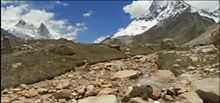Tapovan

Tapovan (Sanskrit) comes from the two root words tapasya - meaning specifically austerity, and more generally spiritual practice, and vana, meaning forest, or wilderness. Tapovan then translates as forest of spiritual practice, wild place for practicing austerities, etc.
Traditionally in India, any place where someone has engaged in serious spiritual retreat may become known as a tapovan. As well as particular caves and other hermitages where sages and sadhus have dwelt, there are some places, such as the western bank of the northern Ganges river around Rishikesh, that have been so used by hermits that the whole area has become known as a tapovan.
Tapovan (place)
The most well known tapovan in India is the area above the Gangotri Glacier at one of the primary sources of the Ganges, in Uttarakhand, India. At the foot of Shivling peak, a barren area at about 4,463m (14640 feet) elevation, is a seasonal home to sevaral sadhus living in caves, huts etc. and it has become a trekking destination also.[1] The trekking usually starts from Gomukh and the trek was considered moderate to difficult [1] prior to the destruction of much of the trail from Gangotri to Gamukh by the 2013 North Indian Floods. Tapovan area is base camp for several mountaineering expeditions including Shivling peak, Bhagirathi peak etc. Tapovan area is full of meadows, streams and flowering plants and the meadows are considered as one of the best high altitude meadow in India.[1] There is also a place named Nandanvan near Tapovan, and Nandavan is also trekked by trekkers and pilgrims.[1] Nandanvan is also a spacious meadow located at the base of Bhagirathi massiff.[2]
References
- ↑ 1.0 1.1 1.2 1.3 "Gomukh Tapovan Trek". Tourmyindia.com. Retrieved 27 June 2013.
- ↑ "The Source of the Ganges Trek". the exotic himalayas.com. Retrieved 27 June 2013.
Coordinates: 30°54′37″N 79°04′50″E / 30.91028°N 79.08056°E